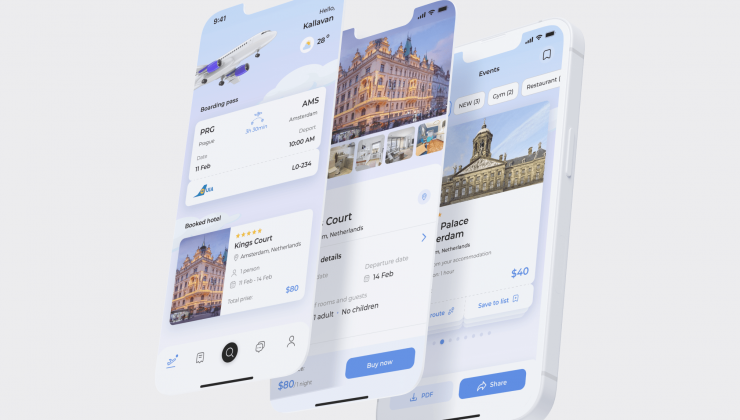In 2025, the cost of Mobile App development might make you think twice.
The first time, you'll marvel at how amazing it is to live in an era where artificial intelligence has become part of our daily routine. After all, process automation should theoretically reduce labor costs and save budgets (spoiler alert: it doesn’t).
The second time, you'll realize that a modern mobile app can’t do without AI functionality (such as personalized recommendations, voice assistants, smart filters, etc.). However, incorporating these features, in turn, affects App development costs in the opposite way - by driving them up.
So, what’s the bottom line? Should we expect costs to decrease or increase? Let’s dive in and find out.
Key statistics

- According to Statista, the mobile app market is projected to reach a staggering $585.70 billion by 2025, reflecting a 9.28% increase compared to 2024.
- While the annual growth rate (CAGR 2022 - 2029) was expected to stay below 7.84%, we are witnessing a significant surge.
- The market's forecasted volume for 2029 is $781.70 billion, but if the growth rate holds steady, this figure could rise to $836.15 billion.
- Revenue from in-app purchases (IAP) alone is anticipated to hit $198.70 billion, while advertising revenue is projected at $381.30 billion.
- The costs to develop an App for iOS is, on average, 15 - 20% higher than for Android. Yet, Apple's market share stands at a commanding 76.9%.
- The expected number of app downloads in 2025 is 303.50 billion, compared to 286.40 billion in 2024. The minimum revenue per download is forecasted to be $1.86.
Overview of Mobile App Development Trends for 2025
- Apps will increasingly leverage AI to predict user behavior and adapt interfaces in real time, offering products and services before users even start searching for them.
- The integration of AR and VR will become more common, providing users with new ways to interact with content and services in immersive environments.
- Apps will be deeply integrated with IoT devices, enabling users to manage connected devices through a single interface and automate everyday tasks seamlessly.
- The popularity of apps that combine multiple services—ranging from financial transactions to delivery and social networking—is expected to grow, offering users an all-in-one tool for various needs.
- Advancements in flexible and foldable screens will pave the way for new device form factors, unlocking additional possibilities for mobile app design and functionality.

Stages of Market Development and Pricing Dynamics
Let’s take a closer look at the evolution of mobile App creation costs over the years, starting from the early days of the industry. We’ll also provide a brief forecast for the current year.

Important! This is not yet the answer to your question, “How much does it cost to build a mobile app?” There’s still a lot to consider, such as the differences in the cost Mobile App native vs. hybrid, types of development technologies, required basic functionality, and much more. The figures you see above could differ significantly from the actual App dev cost, sometimes by 2–5–10 times (in either direction).
Fun Fact. As we can see, the App creation cost continues to rise steadily. There’s no sign of a downward trend - not even under a microscope. But what do analysts' forecasts tell us at this moment?
Gartner states that in 2025, AI will reduce development costs by 40%. This is because a machine writing code instead of a programmer saves not only money but also time! Additionally, the following factors could also lower App development pricing:
- use of low-code/no-code platforms. These are accessible to non-specialists, eliminating the costs of hiring experienced developers;
- potential outsourcing of development to countries with lower rates; AI integration in the process reduces risks associated with poor decisions;
- automation of testing and routine tasks accelerates and optimizes the process.
It is important to understand and accept that, despite its power, artificial intelligence has not yet replaced humans. Instead, it serves as a powerful tool that helps developers work more efficiently and create higher-quality applications.
7 Factors That Will Affect Mobile App Creation Costs in 2025
Creating an app is like building a house. You may want a cozy little cottage or a huge castle. But what will ultimately determine your budget?
Scale and scope of desires. Materials and technologies. Location. The experience and professionalism of the builders you hire. Surprisingly, the mobile development cost is influenced by almost the same factors. Let’s explore the main ones and offer tips on how to save. And what is really worth paying for to ensure your expectations match reality.

1. Functionality Complexity
The number and complexity of features (chats, payment systems, AI integrations, augmented reality). The more complex the logic, the more time and resources it requires.
How to save: Start by launching a minimum viable product (MVP).
Exclude non-essential features at the start. For example, do not implement customer support chat during the launch phase.
Consequences of saving: Saving money might slow down user acquisition if the app does not meet the key needs of the target audience.
2. Approach to Development
This refers to the amount of manual programming required to implement the set tasks. Accordingly, the higher this volume, the higher the cost App. We will delve into this topic in a separate section.
How to save: Use visual interfaces, ready-made modules, and pre-configured components.
Consequences of saving: Much fewer customization options compared to manual development. In other words, cutting costs may result in a product and functionality that do not meet your expectations.
3. Design and UX Costs in Mobile App Development
Quality UX can sometimes take up 30-40% of the total budget. This refers to the level of detail in the design. You can create black-and-white sketches showing the main blocks and interface structure, or you can make an interactive prototype that closely resembles the final product. The right choice of detail level allows for efficient project work, minimizes risks, and creates a high-quality product.
How to save: Use ready-made design templates and UI kits.
Avoid complex animations.
Consequences of saving: Template designs always look outdated or fail to distinguish your business from competitors, which reduces user engagement.
4. Third-Party Integrations and APIs: Cost Considerations
Using third-party solutions (payment systems, maps, analytics) requires time and effort, which also impacts the cost of mobile Apps. Each external integration can cost an additional $2,000 - $5,000.
How to save: Some open APIs can reduce costs by 25%. Avoid expensive third-party services if basic functionality can be implemented within your team. Look for free or budget-friendly alternatives.
Consequences of saving: Budget solutions may be less reliable, leading to failures and a worse user experience.
5. Use of Artificial Intelligence and Automation
AI algorithms simplify development (through automation and reducing risks caused by human factors). However, their implementation requires time and resources.
How to save: Use existing AI solutions like TensorFlow or OpenAI instead of creating custom models.
Consequences of saving: The lack of customization always has a very negative impact on the final product. It becomes template-like and unappealing to users. At a minimum, you will significantly lose functionality in the app.
6. Costs For Testing And Quality Assurance (QA)
The scale of testing (manual, automated), bug fixing. Read more about Software Testing Strategies in our previous article.
How to save: Reduce the scope of testing, covering only key scenarios. Use crowdtesting (testing with real users at a lower cost).
Consequences of saving: A high risk that bugs will ruin users' impression, especially in the early stages.
7. Post-Launch Costs: Maintenance and Updates for Mobile Apps
The price for app development is also influenced by subsequent regular updates, adaptation to new OS versions, server maintenance, etc. This aspect cannot be excluded.
How to save: Minimize the frequency of updates. Use cloud services with a fixed fee instead of creating your own servers.
Consequences of saving: Users may face issues due to outdated apps, which will reduce their loyalty.
Classification of Apps by Development Approach and Its Impact on Cost
We’ve touched on this topic earlier in the text. Now it’s time to dive deeper and discuss how development approaches differ depending on the amount of manual programming involved. Naturally, this factor directly affects app development prices. For convenience, let’s present the data in a table.

As you can see, costs to build an App for Startups vs Large Enterprises differ significantly. In the first case, a quick market entry and cost-efficiency are crucial. Startup budgets are often smaller, averaging between $10,000–150,000. In contrast, corporations are willing to spend from $500,000 to get a premium product. However, with the right approach, an optimal solution can be found for any budget. For example, starting with an MVP to attract investors and understand which features are a priority and need to be implemented first.
Cost Breakdown by App Type
What else can mobile app development expenses depend on? It depends on how complex your requirements and ideas are. Each type of app has its own features, and your choice should be based on the project goals and available budget.

Games remain the leaders in the niche with a share of $215.90 billion in 2024. This is why we decided to place them in a separate category, rather than categorizing them as complex apps. The honorable second position is taken by social networks with a figure of $146.30 billion. And in third place, with a huge gap, is Entertainment (share of $39.80 billion). Surprisingly, medical programs occupy the last position ($1.38 billion).
Total Cost Estimation for Building a Mobile App in 2025
These are the standard basic stages. However, the more complex the app, the more stages will be involved. For example, games or complex enterprise apps will require additional specialists (animators, security experts).
Let's take a look at the mobile app development cost breakdown. The cost is based on average market developer rates ($30–$50 per hour). All calculations are approximate and not a public offer.

Tip! Don't try to cut the budget by skipping stages (such as testing). Yes, it will affect app development rates, but it will also increase the risk of errors and result in a poor-quality product.
In total, based on the table above, the development time for a medium-complexity app will be: 800–1,600 hours.
Development Team: Choosing the Right Resources and Budgeting
6–8 specialists (analyst, project manager, designers, developers, testers, DevOps). Estimated cost: $40,000–150,000.
Want a ballpark figure for a simple mobile app? Here's a breakdown (all in US dollars):
- US and Western Europe: Expect to pay anywhere from $50K to $150K.
- Eastern Europe and Latin America: You'll likely spend between $30K and $100K.
- Asia: This is usually the most affordable option, ranging from $20K to $80K.
Keep in mind, the final cost can fluctuate based on factors like the team's skill level, the size of the team, and the specific tech they're using. For instance, if they need to use some super niche programming languages, your wallet might take a hit.
Features of Mobile Applications: Implementation, Tools, Time, and Cost
What do a mobile shooter, where you run and kill monsters, and your banking app have in common? The core functionality, of course. There are features that are essential for nearly every mobile application. For example, user registration and authentication.
Below, we will list other standard features and their impact on app development charges. As before, the numbers are approximate and only serve as a guideline.


In total, the development time is 300–700 hours. The overall mobile App build cost is $15,000–35,000, depending on the scope of features and the qualifications of the team. Ready-made tools (such as Firebase, Stripe) can also be used. They help reduce development time and costs but may require additional maintenance expenses.
The Role of Artificial Intelligence in Reducing Development Costs
Incorporating artificial intelligence increases development costs by 30–300%, depending on the complexity of the application. AI-based app development requires the creation or adaptation of sophisticated machine learning (ML) and deep learning (DL) models. However, it provides significant competitive advantages by making applications smarter, more personalized, and highly in demand in the market.

To reduce costs for AI solutions, it’s advisable to use ready-made platforms and tools, reserving customization for unique features only.
Conclusions
The cost of building a mobile app continues to rise year by year but can fluctuate depending on market conditions, much like the price of luxury real estate or stocks. This is hardly surprising.
Interestingly, the integration of artificial intelligence can either stretch or balance your budget. On one hand, we see the automation of routine processes. Tools like GitHub Copilot accelerate developer workflows, potentially reducing expenses by 10–20%. On the other hand, user expectations for increasingly sophisticated and powerful features drive costs up.
For example, no one wants to interact with a "dumb" bot that strictly follows templates and fails to adapt its responses to individual situations. However, an "intelligent" bot equipped with advanced capabilities will add several thousand dollars to your development costs.
Cloud solutions, such as Google TensorFlow or AWS SageMaker, often come to the rescue. For instance, developing a voice assistant using Amazon Alexa Skills can cost between $10,000–50,000, while creating a unique custom solution could exceed $100,000.
Another critical factor is the cost of labor for specialists and teams. Our developers are ready to create a product that perfectly fits your business and budget. We excel at finding a balance between cost reduction and maintaining the highest possible quality and functionality.
By choosing us, you’ll not only receive a high-quality application but also a reliable long-term partner to support your business growth.
FAQ
How to Reducing Mobile App Development Costs Without Sacrificing Quality?
Start with an MVP (Minimum Viable Product). Use hybrid platforms like Flutter. Automate processes with AI.
Development team: freelancers or agencies?
Freelancers charge $25–$100/hour and are suitable for small tasks.
Agencies: $100–$250/hour, ideal for large-scale projects.
In-house teams: Paid at market rates for each specialist. Require time and resources to establish. Practical only for very long-term projects where the application is the core of your business operations.
General cost estimate: from and to. What to expect?
The average App development cost in 2025 will range from $5,000 to $250,000, depending on the factors we have detailed in this article.
Artificial intelligence: will it help save costs?
AI is already reducing development costs: automation of testing, code generation, and improved algorithms can save up to 30% of the budget. But this is only one side of the coin. Integrating AI functionality into an existing product significantly increases the app development cost for large projects.
Post-launch costs: how much?
Launch is just the beginning. Updates, bug fixes, and maintenance will cost 15–20% of the cost for application development. Also, don't forget about marketing and promotion, which will cost an additional $5,000–$50,000 per year.
However, with proper approach and planning, this will be a successful investment that will bring excellent dividends to the owner every year.


